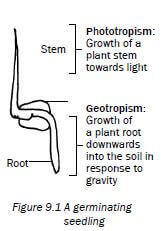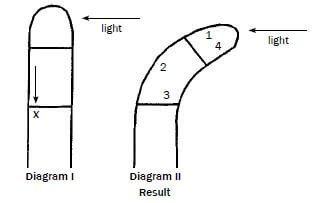RESPONDING TO THE ENVIRONMENT - PLANTS GRADE 12 NOTES - LIFE SCIENCES STUDY GUIDES
Share via Whatsapp Join our WhatsApp Group Join our Telegram GroupRESPONDING TO THE ENVIRONMENT - PLANTS
LIFE SCIENCES
STUDY GUIDES AND NOTES
GRADE 12
- Growth and development in plants
- Role of auxins in phototropism and geotropism
- Plant defence mechanisms
CHAPTER 9: RESPONDING TO THE ENVIRONMENT - PLANTS
9.1 Growth and development in plants
Growth and development in plants are controlled by hormones. Auxin is an example of a hormone.
Tropism is the growth or turning movement of a plant or part of a plant in response to an environmental stimulus.
- Phototropism is the growth of a plant in the direction of a light source.
- Geotropism is the growth of a plant in response to gravity.
The growth movement of phototropism and geotropism is due to chemical messengers (hormones) called auxins in a plant.
Activity 1
Questions
Complete the table:
Term | Description |
a) | Chemical messenger in the plant |
b) | Growth of a plant stem towards light |
Geotropism | c) |
Tropism | d) |
Answers to activity 1
a) Plant hormone✔
b) Phototropism✔
c) Growth of a plant root in response to gravity✔
d) Growth movement of a part of a plant in response to an environmental stimulus✔ [4]
9.2 Role of auxins in phototropism and geotropism
Related Items
Role of auxins in phototropism | Role of auxins in geotropism |
Produced at the tip of stem/shoot | Produced at the tip of roots |
Auxins move downward evenly | Auxins move upwards evenly |
This even distribution brings about equal growth on all sides of the stem | This even distribution brings about equal growth on all sides of the root |
As a result the stem grows upward | As a result the root grows downward |
When the stem is exposed to unilateral light (light from one side only) | When the root is placed horizontally (only one side exposed to gravity) |
The auxin concentration will be high on the dark side - light destroys auxins | The auxin concentration will be high on the lower side of the root - gravity attracts auxins |
More growth occurs on the dark side because auxins stimulate growth on the dark side | More growth occurs on the upper side of the root because auxins on the lower side inhibit growth |
As a result the stem bends towards the light | As a result the root bends downwards |
Activity 2
Questions
QUESTIONS 1 to 2 are based on Diagrams I and II which illustrate the response of the tip of a young shoot to a light stimulus.
- The arrow X represents the unequal distribution of …
- abscisic acid.
- mineral salts.
- gibberellins.
- auxins.
- The curving of the shoot in Diagram II is due to more rapid cell growth in region(s) …
- 1.
- 2.
- 1 and 4.
- 3 and 4.
- The diagram above represents …
- geotropism.
- apical dominance.
- phototropism.
- gravity. 3 × 2 [6]
Answers to activity 2
1. D✔✔
2. B✔✔
3. C✔✔ 3 × 2 [6]
9.3 Plant defence mechanisms
Plants are eaten by herbivores and attacked by pathogenic organisms such as viruses, bacteria and fungi, causing them to become diseased.
Plants protect themselves from these threats using chemicals and thorns.
Activity 3
1. Describe TWO methods used by plants as defence mechanisms (4)
Answers to activity 3
1.
- Plants have thorns✔ on their stems and leaves. They are unable to escape from herbivores, and the thorns are used to protect themselves. ✔
- The chemical secretion of plants is poisinous to some organisms. ✔
- Sticky secretions given of by plants make it difficult for insects and animals to eat the plant ✔ [4]